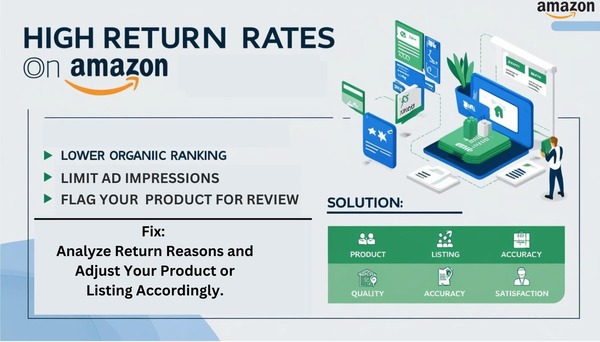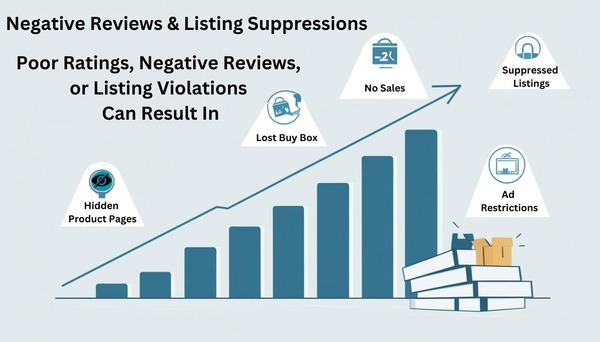Introduction
You’re running Amazon PPC ads. You’re getting clicks. But your sales? They’re either stagnant or, worse, declining. If this sounds familiar, you might assume your campaigns are the problem. However, in many cases, poor ad performance has nothing to do with your PPC strategy—the issue lies in back-end operations.
Amazon’s algorithm prioritizes not just ad efficiency but also listing health, inventory status, customer experience, and product quality. If these elements aren’t optimized, even the best PPC campaigns will struggle to convert traffic into sales. This article explores three major non-advertising factors that could be negatively impacting your conversions and provides actionable solutions to fix them.
Inventory Problems: The Quiet Sales Killer

One of the most prevalent causes of falling conversions is inventory management. If your item is out of stock, low in stock, or has delayed shipping estimates, it will damage your sales. Customers want quick delivery, and if they notice long shipping estimates, they will go to a competitor. Amazon also demotes products that are often out of stock, lowering your visibility and Buy Box eligibility.
When your item is unavailable, not only does it lead to lost sales but also to your long-term performance. Advertising a product that is not available for shipment immediately is a waste of ad money. Even after restocking, you may find it challenging to regain lost rankings and consumer trust. Additionally, Amazon can suppress your product from visibility if it repeatedly sees stock-outs.
To avoid inventory-based sales loss, sellers must actively track their stock levels through Amazon’s Restock Inventory Tool and monitor their Inventory Performance Index (IPI) score. Utilizing Fulfillment by Amazon (FBA) can also assist in guaranteeing quicker delivery options and higher customer satisfaction. A buffer stock policy must be implemented, particularly during peak seasons, to prevent unexpected shortages. Sellers must also consider suspending ads when there is low inventory to avoid unnecessary ad spend.
High Return Rates: A Secret Threat to Your Conversions

Another under-the-radar element that can hurt your ad performance is a high return rate. If your item has a high return rate, Amazon interprets this as a sign that there is something amiss—product quality, listing versus actual product mismatch, or overall dissatisfaction issue. Too many returns not only hurt your product’s ranking but can also trigger listing restrictions or suspension.
Return rates have a direct effect on the effectiveness of your ad spend. Yes, your ads may be driving traffic and revenue, but if you have high refunds, you’re losing money. High return rate might also harm your Order Defect Rate (ODR), an important measure in evaluating your overall account health. A low rating for this measure might restrict your promotional capabilities or even get your account suspended.
To combat high return rates, sellers need to examine the most frequent reasons for returns in their Seller Central reports. If customers return a product repeatedly because of misdescriptions, the listing needs to be revised to give more clarity. High-quality photos and detailed specs need to be added to establish proper expectations. Better packaging and clear usage instructions can also decrease returns due to damage or misuse. Providing good customer service is also likely to fix small problems before they become returns.
Negative Reviews and Hidden Listings: The Conversion Killers

Negative reviews and hidden listings are two of the largest dangers to an Amazon seller’s success. A low product rating has a major effect on conversions since potential customers do not want to buy something that has too many complaints. If your product has a rating of less than four stars, it can hurt sales badly, even if your ads are performing well.
Another significant one is listing suppression. Amazon could suppress or hide a listing for policy infractions, insufficient product information, or inaccurate claims. When a listing is suppressed, all marketing efforts are for nothing because customers will not be able to view the product page. Most of the time, suppressed listings happen because required important information is missing, keyword spamming is happening, or policy infractions have been reported.
To deal with these issues, sellers must actively monitor their product reviews and customer feedback. Getting satisfied customers to leave positive reviews can counterbalance some negative feedback at times. Professionally responding to negative reviews can also show a commitment to customer satisfaction and in some cases even convince reluctant buyers. Periodically reviewing Seller Central’s Listing Quality Dashboard can alert sellers to suppressed listings early on and take action before they impact sales.
Conclusion: PPC Gets the Clicks, But Operations Make the Sale
A successful PPC strategy on Amazon isn’t a matter of making better campaigns—rather, making sure your back-end operations fuel your advertising campaigns. If inventory is volatile, return rates are high, and reviews are subpar, great ads won’t lead to repeatable growth. Sellers need to approach things as a whole and make sure that their listings, stock control, and customer satisfaction are all going in the right direction with regard to their ad strategy. Before tweaking ad campaigns, check your inventory, reviews, and return metrics first. A well-balanced business plan with both innovative marketing strategies and careful operational efficiency will always yield more in the long run. If you’ve been dealing with recurring backend issues—such as server lag, data syncing issues, or inventory management issues—that are adversely affecting your ad performance, let’s discuss focused, actionable solutions to optimize your systems and improve your results!

